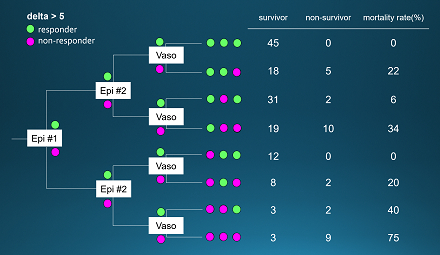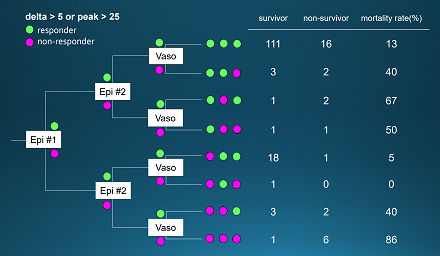Final ID: Su202
Physiological response to vasopressor administration during hemodynamic-directed CPR
Abstract Body: Background: The hemodynamic response to successive vasopressor doses during CPR and its association with survival is poorly defined. Understanding these relationships can facilitate identification of alternative vasopressor strategies. Hypothesis: Non-survival is associated with lower responsivity to successive vasopressors.
Methods: We performed retrospective analysis of hemodynamic data acquired in pediatric swine models (sus scrofa, 9-12kg) of asphyxia-associated ventricular fibrillation cardiac arrest with use of hemodynamic-directed CPR (n=175). Starting 2m into CPR, if hemodynamic targets were not met, vasopressors were given in cycles comprising two doses of 0.02mg/kg epinephrine (Epi) followed by vasopressin (Vaso, 0.4U/kg), separated by a minimum of 1m. After a minimum of 2m, the cycle was repeated. Hemodynamic response was evaluated using the peak diastolic blood pressure (DBP) within 1m for Epi, 2m for Vaso administration and the difference between the initial and peak DBP (delta DBP). Subjects were classified as “responder” if either a delta DBP > 5 mmHg or a peak DBP > 25 mmHg was achieved, and a “non-responder” otherwise. Animals were deemed “survivors” if ROSC was achieved following initial defibrillation.
The change in delta DBP for successive vasopressors was compared in survivors versus non-survivors using two-sided Wilcoxon rank-sum tests. Continuous variables are summarized using the median with interquartile ranges. The burden of “non-response” was used to a construct confusion matrix and calculate performance.
Results: Non-survivors (n=30) had lower delta DBP than survivors (n=145) following successive vasopressor administration at the first cycle (first Epi dose: 7.8 [2.4, 14] vs 16 [7.5, 24], p< 0.01; second Epi: 2.0 [0, 4.7] vs 7.1 [2.0, 12], p< 0.01; Vaso : 1.1 [0, 2.3] vs 7.1 [2.0, 12], p< 0.01). Classification as a “non-responder” at the first cycle (Epi-Epi-Vaso) was significantly predictive of non-survival (Sensitivity 32%, Specificity 92%). Animals that failed to respond to all vasopressors at the first cycle had a significantly increased rate of mortality (86%; 6 non-survivors, 1 survivors) compared to animals that responded to all 3 vasopressors (13%; 16 non-survivors, 111 survivors).
Conclusion: Mortality was significantly associated with lower DBP response to successive vasopressors during hemodynamic-directed CPR in pediatric swine models of cardiac arrest, which may suggest a critical timepoint to activate ECPR.
Methods: We performed retrospective analysis of hemodynamic data acquired in pediatric swine models (sus scrofa, 9-12kg) of asphyxia-associated ventricular fibrillation cardiac arrest with use of hemodynamic-directed CPR (n=175). Starting 2m into CPR, if hemodynamic targets were not met, vasopressors were given in cycles comprising two doses of 0.02mg/kg epinephrine (Epi) followed by vasopressin (Vaso, 0.4U/kg), separated by a minimum of 1m. After a minimum of 2m, the cycle was repeated. Hemodynamic response was evaluated using the peak diastolic blood pressure (DBP) within 1m for Epi, 2m for Vaso administration and the difference between the initial and peak DBP (delta DBP). Subjects were classified as “responder” if either a delta DBP > 5 mmHg or a peak DBP > 25 mmHg was achieved, and a “non-responder” otherwise. Animals were deemed “survivors” if ROSC was achieved following initial defibrillation.
The change in delta DBP for successive vasopressors was compared in survivors versus non-survivors using two-sided Wilcoxon rank-sum tests. Continuous variables are summarized using the median with interquartile ranges. The burden of “non-response” was used to a construct confusion matrix and calculate performance.
Results: Non-survivors (n=30) had lower delta DBP than survivors (n=145) following successive vasopressor administration at the first cycle (first Epi dose: 7.8 [2.4, 14] vs 16 [7.5, 24], p< 0.01; second Epi: 2.0 [0, 4.7] vs 7.1 [2.0, 12], p< 0.01; Vaso : 1.1 [0, 2.3] vs 7.1 [2.0, 12], p< 0.01). Classification as a “non-responder” at the first cycle (Epi-Epi-Vaso) was significantly predictive of non-survival (Sensitivity 32%, Specificity 92%). Animals that failed to respond to all vasopressors at the first cycle had a significantly increased rate of mortality (86%; 6 non-survivors, 1 survivors) compared to animals that responded to all 3 vasopressors (13%; 16 non-survivors, 111 survivors).
Conclusion: Mortality was significantly associated with lower DBP response to successive vasopressors during hemodynamic-directed CPR in pediatric swine models of cardiac arrest, which may suggest a critical timepoint to activate ECPR.
More abstracts on this topic:
Differential Outcomes After Cerebrovascular Accident-Related Out-of-Hospital Cardiac Arrest With and Without Initial Shockable Rhythm
Tateishi Kazuya, Saito Yuichi, Kitahara Hideki, Kobayashi Yoshio, Tahara Yoshio, Yonemoto Naohiro, Ikeda Takanori
A Multicentre Study for Hands Only CPR (HOCPR) training assessment towards building a ‘Nation of Life Savers” in IndiaRavikumar Thanjavur, Sarma Kvs, Ravikumar Thanjavur, Sarkar Manuj, Debnath Dhrubajyoti, Behera Priyamadhaba, Ghate Jayshri, Trikha Divay, Samantaray A, Madhavi K


